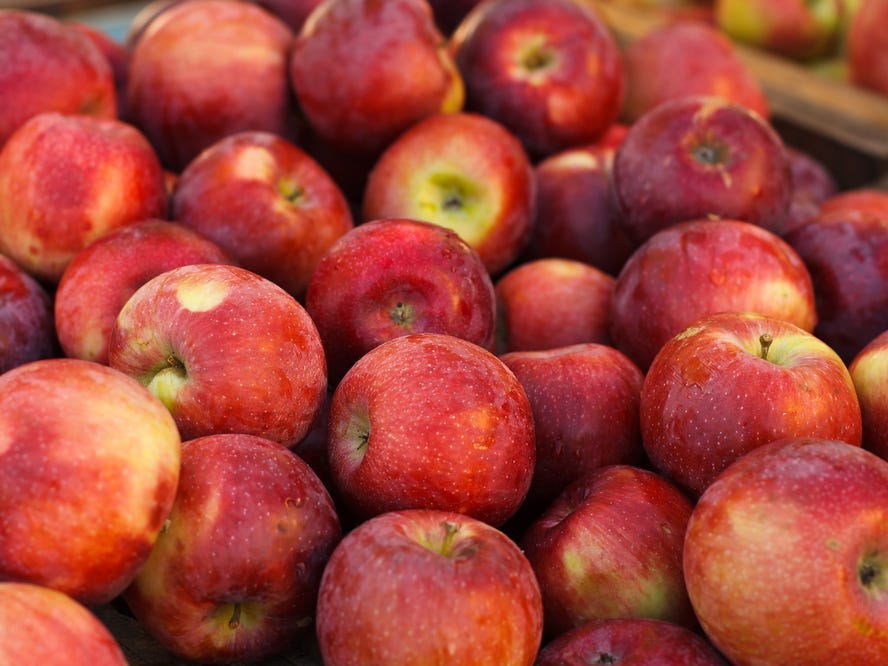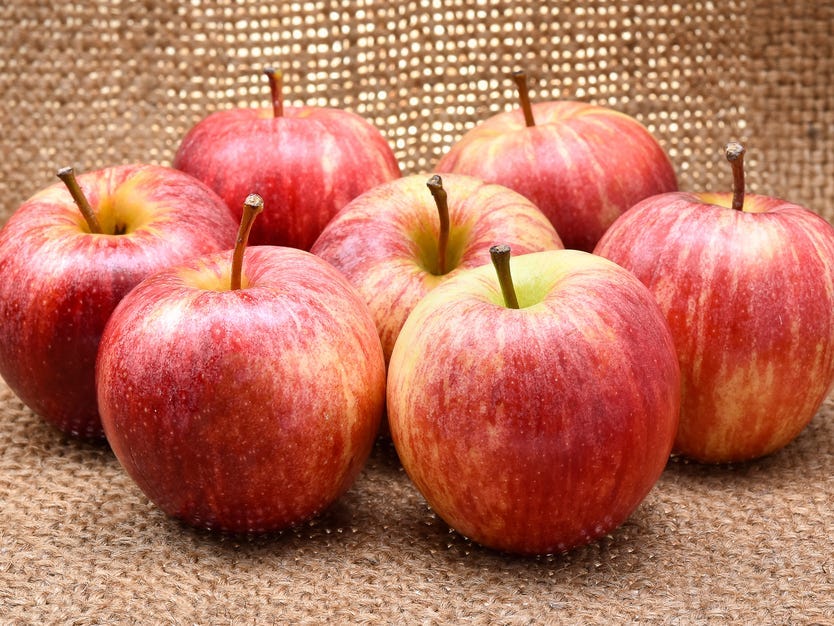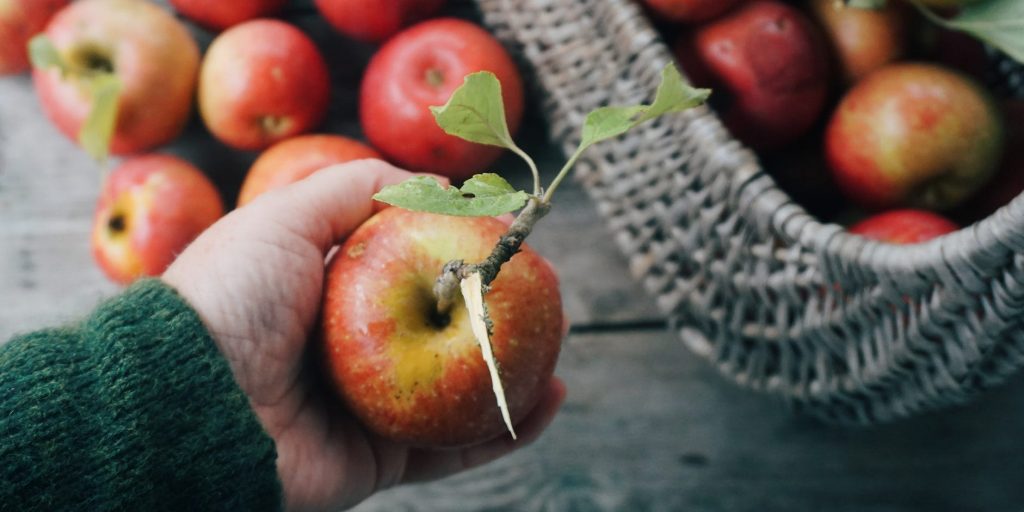
Merethe Svarstad Eeg / EyeEm/Getty Images
- There are thousands of apple varieties, hailing from around the world.
- Some apples, like Gala, were intentionally cultivated and others, like McIntosh, were discovered.
- Some apple varieties like Granny Smiths are best baked into pies, while others like Fujis should be eaten fresh.
- Visit Insider's Home & Kitchen Reference library for more stories.
Throughout the centuries, apple varieties have fallen in and out of favor. Most apples were originally planted in the United States for making hard cider. And, if you were to taste most of those, you would immediately spit them out, due to their intense bitterness and acidity.
Simon Renault, general manager of Scott Farm in Dummerston, Vermont explains that many of those unsnackable apple varieties are prized in cidermaking for their complexity and depth. Much like wine grapes, eating apples and cider apples generally don't overlap, with a few noteworthy exceptions.
After prohibition hit in the United States, focus shifted toward eating apples. In fact, private labs and universities across the world, such as Cornell University, went to work to develop eating varieties for the general public.
The way apples are propagated is unique. If you eat an apple and want that kind of apple tree, you must find that apple tree again, take a piece of wood from it, and graft it onto an existing tree. "For most plants, if you like it, you put a seed in the ground and wait for it to grow," says Renault. "[With apples] You have to make a very conscious decision."
Many of the over 130 apple varieties grown at Scott Farm are over 100 years old, and some date back to the 1500s. While there are thousands of apple varieties across the globe, here are 17 of the best-known eating apple varieties for snacking, cooking, or baking.
Granny Smith

Thn Rocn Khosit Rath Phachr Sukh / EyeEm/Getty Images
Originally from Australia, Granny Smith Apples are thought to be a cross between wild apples and domesticated apples. They tend to prefer warmer climates, and are often grown in Washington. Granny Smiths are one of the most popular grocery store varieties of apple, and while they make for a tart, refreshing snack, they're especially loved for pies.
Fuji

GomezDavid/Getty Images
Fuji apples are a cross between Red Delicious and a lesser-known variety called Ralls Janet. It was first cultivated in Fujisaki, Japan in the 1930s and started being sold commercially in the 1960s. It is one of the most popular apple varieties in the US and easily the most popular in Japan, thanks to its crispness and concentrated fruity flavor.
Braeburn

barmalini/Shutterstock
Braeburn apples are a cross between Lady Hamilton and Granny Smith apples. Though they're grown around the world, they originate from New Zealand. Given they hold their texture well when heated, Braeburn apples work perfectly for cooking but can also offer a refreshing snack.
Gravenstein

tfoxfoto/Getty Images
Because of their rich flavor, American horticulturist pioneer Luther Burbank says: "If the Gravenstein could be had throughout the year, no other apple need be grown." Although these apples don't last well in storage, they are prized for cooking and cider making. Slow Food USA included the Gravenstein apple in its "Ark of Taste," a catalog of endangered foods.
Baldwin

Greg Kushmerek/Shutterstock
In the 1700s and 1800s, Baldwin apples were among the most popular varieties in New England. Unfortunately, a harsh winter in the 1930s wiped out most of New England's Baldwin apple tree population. Because they hold their shape well when heated, they're great for pies and are often used for cider. In 2013, they were one of four apple varieties included by USPS in their apple postage stamp series, along with Granny Smith, Northern Spy, and Red Delicious.
Northern Spy

geoBee/Shutterstock
Northern Spy apples are loved for their concentrated, tangy flavor and their use in just about anything that you might need an apple for, from pies to cider. They first popped up in the mid-1840s in New York State, and are still quite popular there. Because it can be susceptible to bruising and disease, it's not widely grown on a commercial level.
Jonagold

Zigzag Mountain Art/Shutterstock
Jonagold apples, a cross between golden delicious and Jonathan apples, were developed by Cornell University in 1953. They are favored for their large size. Jonagold apples have "sterile" pollen, meaning they are incapable of being crossed with other types.
Newtown Pippin

GomezDavid/Getty Images
Thomas Jefferson wrote in a letter from Paris, "they have no apples here to compare with our Newtown Pippin." There is a wide range of heirloom Pippin varieties, but the Newtown Pippin is one of the more popular types in the United States. Originally discovered in Queens in the early 1600s, they are now grown throughout New England for a wide variety of uses.
Red Delicious

Sergio Mendoza Hochmann/Getty Images
If you've spent much time in America in the past 50 years, you've likely come across a Red Delicious or two. Between 1968 and 2018, it was the most cultivated variety in the United States (the Gala has since surpassed it). However, due to having been bred for uniformity, color, and storage, it has unfortunately become known for its lack of flavor in recent years.
Golden Delicious

Shulevskyy Volodymyr/Shutterstock
Perhaps surprisingly, Golden Delicious apples are not a close relative of Red Delicious apples. Originally discovered in 1905 in West Virginia, Golden Delicious apples are now widely cultivated and prized for their sweetness and flavor. In 2010, a project was undertaken to study their genome and it turned out that the apple has 57,000 genes, which is more than any other plant genome ever studied.
McIntosh

Brent Hofacker/Shutterstock
Discovered in Canada by John McIntosh in the 1800s, this apple was a McIntosh family favorite (dubbed "Granny's apple" by the kids) until the 1900s, when it reached more commercial use. It is now known as the national apple of Canada, and is famously the name inspiration for Macintosh computers.
Empire

Elliotte Rusty Harold/Shutterstock
Empire apples were created by a Cornell University fruit nutritionist in the mid-1950s, and were introduced to the commercial market in the 1960s. Because they are resistant to bruising, they are known as an excellent "lunch box apple."
Winesap

Zigzag Mountain Art/Shutterstock
Winesap apples are another variety that dates back to colonial times. It's thought to have been discovered in New Jersey and was most popular before the 1950s. It's known for its small size and rich flavor.
Pink Lady®

Surasak Klinmontha/Shutterstock
Pink Lady® apples are actually a trademark, owned by Apple and Pear Australia Limited (APAL). Anything labeled as a Pink Lady can include a few different types of apple, most famously Cripps Pink. In order to be sold under the Pink Lady® name, they must meet certain criteria for sugar content, appearance, and firmness. They were originally bred in Australia by John Cripps, who crossed Lady Williams and Golden Delicious. Pink Lady® apples are known for their long growing season and their tart, sweet flavor.
Honeycrisp

wholden/Getty Images
Honeycrisp apples were created in a laboratory in Minnesota in the 1970s and started being sold in 1991 after its patent was secure. It is now the state fruit of Minnesota. Honeycrisp is a noteworthy commercial apple variety, as it was truly bred for balanced flavor, rather than for its storage abilities or supply chain resilience. It is one of the most cultivated apples in America.
Gala

Wealthylady/Shutterstock
As of 2018, Gala apples are the most popular variety in the United States. Another apple type that hails from New Zealand, they originally were a cross between Golden Delicious and Kidd's Orange Red. There are many subtypes of Gala apples, but Royal Gala, known for its freshness and concentrated flavor, is the most popular.
Cortland

Fudio/Getty Images
A descendant of the McIntosh, Cortland apples were developed in New York state in the late 1800s. It is one of the top 20 most popular apples in the United States. Because they're resistant to disease, they are a popular apple for home growers as well.
Insider's takeaway
Though your childhood lunchbox may not have reflected this, there is a wide, weird world of apples out there. Some, like the Newtown Pippin, date back to colonial America or beyond, and some were created in university labs. While apples for cider and apples for eating and cooking are typically quite different, some like the Northern Spy, are excellent for all of the above.
